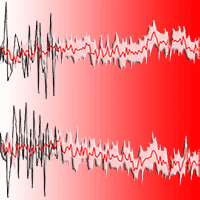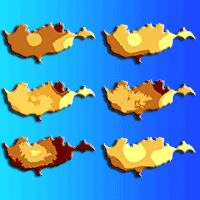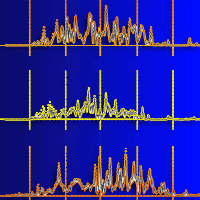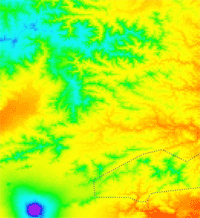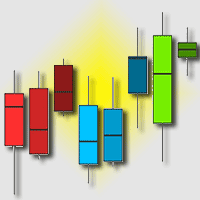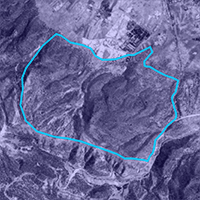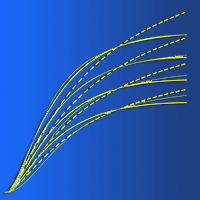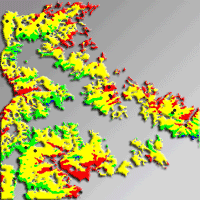We analyzed the behavior of forest fires for daily prediction purposes in one of the regions with the highest fire incidence in Mexico. The main objective was to build logistic regression models (LRMs) for daily prediction of forest fire ignition based on meteorological drought indices. We built 252 LRMs for seven types of vegetation cover of greater representativeness and interest for the study area. Three dynamic variables were considered to estimate daily dryness in combustible fuels based on the effective drought index and the standardized precipitation-evapotranspiration index. Additionally, two weather data sources were included in drought indices: conventional weather stations (CWS) and automatic weather stations (AWS). Prediction efficiency assessment for LRMs was done through the relative operating characteristic (ROC) and model precision efficiency (MPE). The results show that LRMs using data from CWS performed relatively better than those based on data from AWS, as the former data sources have higher spatial density and thus generate predictions with higher accuracy (ROC ≥ 0.700, MPE ≥ 0.934). For both data sources, the use of standardized precipitation-evapotranspiration index as a fuel dryness estimator is recommended, as it reflects an atmospheric moisture balance between precipitation and reference evapotranspiration (ROC ≥ 0.734, MPE = 1). Such predictive models can be used as inputs in early warning systems for forest fire prevention or mitigation.
Keywords
, , , ,
Citation
Vilchis-Francés AY, Díaz-Delgado C, Becerril Piña R, Mastachi Loza CA, Gómez-Albores MÁ, Bâ KM (2021). Daily prediction modeling of forest fire ignition using meteorological drought indices in the Mexican highlands. iForest 14: 437-446. - doi: 10.3832/ifor3623-014
Academic Editor
Davide Ascoli
Paper history
Received: Aug 11, 2020
Accepted: Jul 28, 2021
First online: Sep 28, 2021
Publication Date: Oct 31, 2021
Publication Time: 2.07 months
© SISEF - The Italian Society of Silviculture and Forest Ecology 2021
Open Access
This article is distributed under the terms of the Creative Commons Attribution-Non Commercial 4.0 International (https://creativecommons.org/licenses/by-nc/4.0/), which permits unrestricted use, distribution, and reproduction in any medium, provided you give appropriate credit to the original author(s) and the source, provide a link to the Creative Commons license, and indicate if changes were made.

Breakdown by View Type
(Waiting for server response...)
Article Usage
Total Article Views: 32388
(from publication date up to now)
Breakdown by View Type
HTML Page Views: 27316
Abstract Page Views: 2053
PDF Downloads: 2492
Citation/Reference Downloads: 6
XML Downloads: 521
Web Metrics
Days since publication: 1553
Overall contacts: 32388
Avg. contacts per week: 145.99
Article Citations
Article citations are based on data periodically collected from the Clarivate Web of Science web site
(last update: Mar 2025)
(No citations were found up to date. Please come back later)
Publication Metrics
by Dimensions ©
Articles citing this article
List of the papers citing this article based on CrossRef Cited-by.
(1)
Aguado I, Camia A (1998)Fundamentos y utilización de índices meteorológicos de peligro de incendio [Fundamentals and use of meteorological fire hazard indices]. Serie Geográfica 7: 49-58. [in Spanish]
Online |
Gscholar
(2)
Ali AA, Carcaillet CH, Bergeron Y (2009)Long-term fire frequency variability in the eastern Canadian boreal forest: the influences of climate
vs. local factors. Global Change Biology 15 (5): 1230-1241.
CrossRef |
Gscholar
(3)
Andela N, Morton DC, Giglio L, Paugam R, Chen Y, Hantson S, Van Der Werf GR, Randerson JT (2019)The global fire atlas of individual fire size, duration, speed and direction. Earth System Science Data 11 (2): 529-52.
CrossRef |
Gscholar
(4)
Andrews PL, Loftsgaarden DO, Bradshaw LS (2003)Evaluation of fire danger rating indexes using logistic regression and percentile analysis. International Journal of Wildland Fire 12 (2): 213-26.
CrossRef |
Gscholar
(5)
Arndt N, Vacik H, Koch V, Arpaci A, Gossow H (2013)Modeling human-caused forest fire ignition for assessing forest fire danger in Austria. iForest - Biogeosciences and Forestry 6: 315-25.
CrossRef |
Gscholar
(6)
Ayala FJ, Olcina J (2002)Riesgos naturales [Natural hazards]. Ariel SA, Barcelona, Spain, pp. 1304. [in Spanish].
Gscholar
(7)
Byun HR, Wilhite DA (1999)Objective quantification of drought severity and duration. Journal of Climate 12: 2747-56.
CrossRef |
Gscholar
(8)
Carrillo RL, Rodríguez DA, Tchikoué H, Monterroso AI, Santillan J (2012)Análisis espacial de peligro de incendios forestales en Puebla, México [Spatial analysis of forest fire danger in Puebla, Mexico]. Interciencia 37 (9): 678-683. [in Spanish]
Online |
Gscholar
(9)
CONAFOR (2010)Incendios forestales guía práctica para comunicadores [Forest fires practical guide for communicators]. Comisión Nacional Forestal, Zapopan, Jalisco, México, pp. 56. [in Spanish]
Online |
Gscholar
(10)
CONAFOR (2020)Home page. Comisión Nacional Forestal - CONAFOR, web site.
Online |
Gscholar
(11)
Depicker A, De Baest B, Baetens JM (2020)Wildfire ignition probability in Belgium. Natural Hazards and Earth System Sciences 20: 363-76.
CrossRef |
Gscholar
(12)
Fernandes PM (2019)Variation in the Canadian fire weather index thresholds for increasingly larger fires in Portugal. Forests 10 (10): 1-16.
CrossRef |
Gscholar
(13)
Flores JG, Benavides JD, Leal HD, Vega DG, Valdez C, Casillas UD (2016)Descripción de variables para definición de peligro de incendios forestales en México [Description of variables to define the danger of forest fires in Mexico]. Instituto Nacional de Investigaciones Forestales, Agrícolas y Pecuarias, Jalisco, México, pp. 72. [in Spanish]
Online |
Gscholar
(14)
Guns M, Vanacker V (2012)Logistic regression applied to natural hazards: rare event logistic regression with replications. Natural Hazards Earth System Sciences 12 (6): 1937-1947.
CrossRef |
Gscholar
(15)
Guo F, Wang G, Su Z, Liang H, Wang W, Lin F, Liu A (2016)What drives forest fire in Fujian, China? Evidence from logistic regression and random forests. International Journal of Wildland Fire 25 (5): 505-19.
CrossRef |
Gscholar
(16)
Guo F, Su Z, Wang G, Sun L, Tigabu M, Yang X, Hu H (2017)Understanding fire drivers and relative impacts in different Chinese forest ecosystems. Science of The Total Environment 605- 606: 411-25.
CrossRef |
Gscholar
(17)
Hadisuwito AS, Hassan FH (2018)Selection drought index calculation methods using electre, topsis, and analytic hierarchy process. International Journal of Engineering and Technology 7: 188-193.
Online |
Gscholar
(18)
Hargreaves GH, Samani ZA (1985)Reference crop evapotranspiration from temperature. Applied Engineering in Agriculture 1 (2): 96-99.
CrossRef |
Gscholar
(19)
Hong H, Tsangaratos P, Ilia I, Liu J, Zhu AX, Xu C (2018)Applying genetic algorithms to set the optimal combination of forest fire related variables and model forest fire susceptibility based on data mining models. The case of Dayu County, China. Science of The Total Environment 630: 1044-56.
CrossRef |
Gscholar
(20)
Hosmer DW, Lemeshow S, Sturdivant RX (2013)Applied logistic regression. Wiley, Danvers, MS, USA, pp. 528.
Gscholar
(21)
INEGI (2020)Home page. Instituto Nacional de Estadística y Geografía - INEGI, web site.
Online |
Gscholar
(22)
Madrigal J, Hernando C, Guijarro M, Díez C (2007)El uso de modelos logísticos para la predicción de la regeneración post-incendio de
Pinus pinaster Ait.: aplicación al incendio de Robledillo de Gata (Sierra de Gata, Cáceres) [The use of logistic models for the prediction of post-fire regeneration of
Pinus pinaster Ait.: application to the Robledillo de Gata fire (Sierra de Gata, Cáceres)]. Sociedad Española de Ciencias Forestales 23: 215-220 [in Spanish]
Online |
Gscholar
(23)
Magnussen S, Taylor SW (2012)Prediction of daily lightning- and human-caused fires in British Columbia. International Journal of Wildland Fire 21: 342-56.
CrossRef |
Gscholar
(24)
Martell DL, Otukol S, Stocks BJ (1987)A logistic model for predicting daily people-caused forest fire occurrence in Ontario. Canadian Journal of Forest Research 17: 394-401.
CrossRef |
Gscholar
(25)
Martínez J, Chuvieco E, Martín P (2004)Estimación de factores de riesgo humano de ignición en España mediante regresión logística 1 [Estimation of human ignition risk factors in Spain using logistic regression 1]. In: “Memorias del II Simposio Internacional sobre políticas, planificación y economía de los programas contra incendios forestales” (González-Cabán A ed). General Technical Report PSW-GTR-208, Córdoba, Spain, pp. 281-293. [in Spanish]
Online |
Gscholar
(26)
McEvoy DJ, Hobbins M, Brown TJ, VanderMolen K, Wall T, Huntington JL, Svoboda M (2019)Establishing relationships between drought indices and wildfire danger outputs: a test case for the California-Nevada drought early warning system. Climate 7 (52): 1-15.
CrossRef |
Gscholar
(27)
Pacheco CE, Aguado I, Nieto H (2009)Análisis de ocurrencia de incendios forestales causados por rayo en la España peninsular [Analysis of the occurrence of forest fires caused by lightning in mainland Spain]. GeoFocus 9: 232-249. [in Spanish]
Online |
Gscholar
(28)
Padilla M, Vega-García C (2011)On the comparative importance of fire danger rating indices and their integration with spatial and temporal variables for predicting daily human-caused fire occurrences in Spain. International Journal of Wildland Fire 20 (1): 46-58.
CrossRef |
Gscholar
(29)
Pontius RG (2002)Statistical methods to partition effects of quantity and location during comparison of categorical maps at multiple resolutions. Photogrammetric Engineering and Remote Sensing 68 (10): 1041-1049.
Online |
Gscholar
(30)
PROBOSQUE (2020)Reporta incendios forestales [Report forest fires]. Protectora de Bosques PROBOSQUE, Mexico, web site. [in Spanish]
Online |
Gscholar
(31)
Pyne SJ, Andrews PL, Laven RD (1996)Introduction to wildland fire. John Wiley and Sons, New York, USA, pp. 769.
Gscholar
(32)
Rodrigues M, Costafreda-Aumedes S, Comas C, Vega-García C (2019)Spatial stratification of wildfire drivers towards enhanced definition of large-fire regime zoning and fire seasons. Science of the Total Environment 689: 634-644.
CrossRef |
Gscholar
(33)
Ruiz JD, Reyes FJ (2005)Geografía física aplicada [Applied physical geography]. Servicio de Publicaciones y Divulgación Científica, Universidad de Málaga, Málaga, Spain, pp. 505 [in Spanish]
Gscholar
(34)
Sánchez JM (2016)Análisis de calidad cartográfica mediante el uso de la matriz de confusión [Cartographic quality analysis using the confusion matrix]. Pensamiento Matemático VI (2): 9-26. [in Spanish]
Online |
Gscholar
(35)
SMA (2009)Incendios forestales en el Estado de México y sus emisiones a la atmósfera [Forest fires in the State of Mexico and their emissions to the atmosphere]. Secretaría del Medio Ambiente, Estado de México, México, pp. 30. [in Spanish]
Online |
Gscholar
(36)
Turco M, Marcos-Matamoros R, Castro X, Canyameras E, Llasat MC (2019)Seasonal prediction of climate-driven fire risk for decision-making and operational applications in a Mediterranean region. Science of The Total Environment 676: 577-583.
CrossRef |
Gscholar
(37)
Varol T, Ertugrul M, Özel HB (2017)Drought-forest fire relationships. Mediterranean Identities-Environment, Society, Culture 12: 283-303.
CrossRef |
Gscholar
(38)
Vega C, Woodard PM, Titus SJ, Adamowicz WL, Lee BS (1995)A logit model for predicting the daily occurrence of human caused forest fires. International Journal of Wildland Fire 5 (2): 101-111.
CrossRef |
Gscholar
(39)
Vélez R (1995)El peligro de incendios forestales derivado de la sequía [The danger of forest fires derived from the drought]. Cuadernos de la Sociedad Española de Ciencias Forestales 2: 99-109. [in Spanish]
Online |
Gscholar
(40)
Vicente-Serrano SM, Berguería S, López-Moreno JI (2010)A multi-scalar drought index sensitive to global warming: the standardized precipitation evapotranspiration index - SPEI. Journal of Climate 23 (7): 1696-1718.
CrossRef |
Gscholar
(41)
Vicente-Serrano SM, Berguería S, Lorenzo-Lacruz J, Camarero JJ, López-Moreno JI, Azorin-Molina C, Revuelto J, Morán-Tejeda E, Sanchez-Lorenzo A (2012)Performance of drought indices for ecological, agricultural, and hydrological applications. Earth Interactions 16 (10): 1-27.
CrossRef |
Gscholar
(42)
Vilar L, Martín P, Martínez J (2008)Empleo de técnicas de regresión logística para la obtención de modelos de riesgo humano de incendio forestal a escala regional [Use of logistic regression techniques to obtain models of human risk of forest fire on a regional scale]. Boletín de la Asociación de Geógrafos Españoles 47: 5-29. [in Spanish]
Online |
Gscholar
(43)
Vilchis-Francés AY, Díaz-Delgado C, Magaña-Lona D, B KM, Gómez-Albores MA (2015)Territorial modeling for danger of wildfires with daily prediction in the Balsas River basin. Agrociencia 49 (7): 803-820.
Online |
Gscholar
(44)
Villers ML (2006)Incendios forestales [Forest fires]. Ciencias 81: 61-66. [in Spanish]
Online |
Gscholar
(45)
WMO (2018)Guide to instruments and methods of observation. Volume I - Measurement of meteorological variables. World Meteorological Organization - WMO, Geneva, Switzerland, pp. 573.
Online |
Gscholar
(46)
Zhang Y, Lim S (2019)Drivers of wildfire occurrence patterns in the inland riverine environment of New South Wales, Australia. Forests 10 (6): 1-17.
CrossRef |
Gscholar



